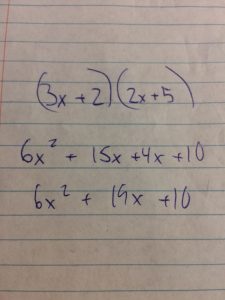This week in math we learned about intercepts. Intercepts are the points on the graph where the line touches either the x or y axis. You can also find the x or y intercepts given a equation. This is done by replacing either the x or y values with zero and solving for x or y.
To find the x intercept, you replace the value of y in your expression with zero. If you are finding the y intercept, you replace the value of x with zero. Then solve the expression.
Example equation: 3x + 2y = 24
X- intercept:
3x + 2(0) = 24
3x = 24
x= 8
X-intercept = (8, 0)
Y- intercept:
3(0) + 2y = 24
2y = 24
y = 12
Y-intercept = (0, 12)










